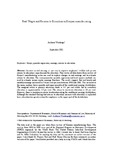| dc.description.abstract | Increase in real earnings is one way to improve employees’ welfare and private
returns to education shape demand for education. Four waves of data drawn from surveys of
Kenya’s manufacturing sector are used to explore changes in real earnings and to estimate
returns to education. The semi-parametric quantile regression and least squares methods are
used to estimate human capital earnings functions. The results suggest, that real hourly and
monthly earnings increased by 5-6 per cent per year between 1993 and 2000. This occurred at
the mean, median, lower quantile and upper quantile of the conditional earnings distribution.
The marginal return to primary education stands at 4-5 per cent while that to secondary
education is approximately 13 per cent. The return to university education is 26 per cent.
However, there is variation in returns to education along the conditional earnings distribution.
Although the standard finding that returns to education increase with education is replicated
here, education has greater return for employees in the upper part of the distribution | en_US |

